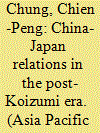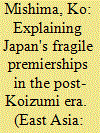| Srl | Item |
| 1 |
ID:
112626


|
|
|
|
|
| Publication |
2012.
|
| Summary/Abstract |
The tenure of Japanese Prime Minister Junichiro Koizumi (2001-2006) was vexing for China-Japan relations. As such, the five years since Koizumi left office, particularly the change in Japan's ruling party, were initially expected, and sometimes perceived, to realize a half-decade of recovery and reconciliation in Sino-Japanese ties. While tensions did decrease, "icebergs" blocking improvement in relations have not completely thawed, and may harden again. Competition for political and economic influences and interests in the same region, concern over one another's future security posture and relations with Taiwan, territorial disputes, misunderstanding about the other's historical sensitivities and feelings of distrust, occasionally manipulated by nationalists, still pervade the relationship. Therefore, though there is mutual desire, indeed a necessity, for cooperation on many issues affecting both countries, this typically couples with a disconcerting or anxious feeling towards the other's intentions that results in competitiveness. There are deep roots to this need/fear complex.
|
|
|
|
|
|
|
|
|
|
|
|
|
|
|
|
| 2 |
ID:
117037


|
|
|
|
|
| Publication |
2012.
|
| Summary/Abstract |
After Prime Minister Junichiro Koizumi's highly successful rule, Japan saw the five short-lived premierships - Shinzo Abe, Yasuo Fukuda, Taro Aso, Yukio Hatoyama, and Naoto Kan - over the period of five years (2006-11). This article aims to identify the causes of this unusually high frequency of Japan's leadership changes in recent times. Specifically, it finds that all post-Koizumi prime ministers lost power after a short tenure by following the same pattern of demise that was characterized by a rapid fall of approval rate in the media's polls. It argues that they fell into this pattern of failure for the same three reasons: their failure in economic policy; their poor leadership ability derived from the vanishing of the traditional career path to premiership; their unstable intraparty foothold caused by the transition from candidate-centered election to party-centered election. It argues that the politics under the Koizumi and post-Koizumi cabinets share important undercurrents despite their apparent differences.
|
|
|
|
|
|
|
|
|
|
|
|
|
|
|
|